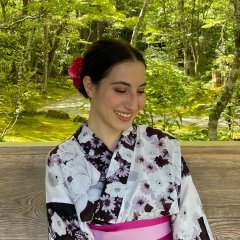Skeleton flowers, also known as glass flowers, Diphylleia grayi, and sankayou (サンカヨウ) in Japanese, are special flowers that become transparent after prolonged periods of moisture—resulting in skeletal or glass-like petals.
These seemingly fictional, yet entirely real flowers are native to mountainous regions in central and northern Japan, as well as Sakhalin in Russia.
Characteristics of skeleton flowers
Skeleton flowers are 30–70 cm (12–31 in) tall and are characterized by their large green leaves and clusters of six-petaled flowers. Typically, the petals appear white—not due to white pigmentation but because of tiny air bubbles in the cells that reflect light. When moisture enters the petals, the cells cannot reflect light as easily, leading to transparent petals.


When and under what conditions can you see skeleton flowers?
These ethereal flowers bloom between May and July, and the flowering period generally lasts about one week.
It is important to note that to see the transparent petals, numerous conditions must align. You cannot simply pour water on a skeleton flower’s petals and expect them to instantly become see-through.
Necessary conditions:
- Light rainfall, morning dew, or thick fog over a long period of time
- Low temperature with high humidity
If the rainfall is too strong, the petals will fall off. Of course, all of these conditions must occur during the flower’s short blooming period.
Although encountering transparent skeleton flowers in the wild can be difficult, the magical visuals are well worth the effort, especially for plant enthusiasts.
Where can you see skeleton flowers in Japan?

Skeleton flowers are alpine plants that grow in cool, slightly damp mountainous areas. Listed below are some specific places where you can find this flower. The “Best time to visit” dates are based on previous years and may fluctuate according to current years’ conditions.
| Place name | Prefecture | Best time to visit | Helpful links | Past info |
| Mt. Moiwa | Hokkaido | May to June | Mt. Moiwa | N/A |
| Shirakami Sanchi | Akita | May to mid-June | Sankayou in Shirakami Sanchi | N/A |
| Ozegahara (Hatomachi-toge Pass) | Gunma | Late May to mid-June | Oze National Park | 2023 2023 2024 |
| Tsugaike Nature Park | Nagano | Late June to early July | Tsugaike Nature Park | 2023 2024 |
| Nozawa Onsen Snow Resort | Nagano | Early to mid-June | Nozawa Onsen Snow Resort | N/A |
| Shiga Kogen (Shinano-ki Trail) | Nagano | Late May to mid-June | Shiga Kogen | 2023 2024 |
| Togakushi Forest Botanical Garden (Plant Observation Garden (植物観察園)) | Nagano | May | Togakushi Forest Botanical Garden May flower blooming info | N/A |
| Kamikochi (Myojin & Tokusawa) | Nagano | Late May to early June | Kamikochi | 2023 |
| Amou Prefectural Natural Park | Gifu | June | Amou Prefectural Natural Park | N/A |
| Hirayu Campground | Gifu | Early to mid-May | Hirayu Campground | 2024 2024 |
| Oku Daisen (Kitanizawa Stream (木谷沢渓流)) (Mt. Giboshiyama (擬宝珠山)) | Tottori | Late April to May | Oku Daisen | 2024 |
| Mt. Oyorogi | Shimane | May | Sankayou of Mt. Oyorogi | N/A |










